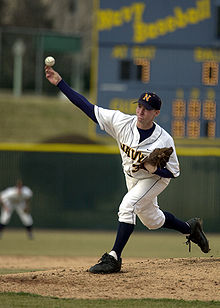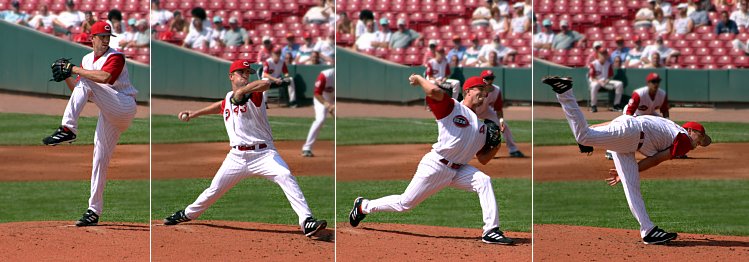Pitcher
![]()
This article is about the player in baseball. For other meanings, see Pitcher (disambiguation).
The pitcher is a player and/or position in the sport of baseball and softball. The pitcher is often referred to in German as Werfer. While his team is fielding, he usually stands in the middle of the infield on the pitcher's mound, a mound about 30 cm high, and throws the balls from there to the respective batter (also called hitter) of the batting team, or the catcher of his own team crouching behind. A good pitcher is characterized by hard-to-hit pitches. Several different throwing techniques are used (e.g. fastball - the most used throw -, changeup, curveball, slider, knuckleball) to make the pitches harder for the batter to calculate.
The pitcher is the most specialized position in the game of baseball. Since he is constantly in action, he usually has to be replaced at least once during the game and - especially in the US professional leagues with their many encounters - often plays only every fourth to fifth game at all. Some pitchers specialize additionally for the player opening (starting pitcher), middle game (reliever or setup man) or final game phase (closer).
The goal of the pitcher is to get hitters out. This can be done by the strikeout, by the fly out or - as a third possibility - by the ground out. It is essential to prepare well before the game, which means to scout the opposing team to analyze their strengths and weaknesses. The basic strategy is to disrupt the hitter's timing. This is done by changing the speed and locations of the pitches ("change speed and locations"). A pitcher's repertoire (also called stuff) should include not only the fastball but also slow offspeed pitches (e.g. the changeup, palm ball and knuckleball), and breaking balls (e.g. slider, cutter, splitter, curveball), i.e. balls that change their direction of flight significantly, are equally important. This allows the hitter not to fixate on one pitch ("to keep the hitter honest"). It is very important that the throwing motion and the pitches remain indistinguishable to the hitter as long as possible. The movement should therefore be as late as possible. Generally, it is considered risky to pitch to the top of the strike zone because hitters can hit those balls farther. It is also considered safer to pitch outside (the so-called outside edge of the strike zone) away from the hitter, but this is highly dependent on the hitter.
Because most pitchers are poor hitters due to their concentration on throwing, it has been allowed since the 1960s in some leagues - including the German Bundesliga and the American League - as well as in international games, that the pitcher completely sits out the offense and a tenth player, the designated hitter, bats instead. The designated hitter then sits out on defense. However, other leagues - most notably the National League and many recreational leagues - do not allow this. In matchups between teams from two leagues that regulate this differently, the home team's rule applies. In most cases, there is a separate warm-up area for the pitcher, called the bullpen.

A pitcher throwing a curveball
Throwing motion
The throwing motion has become very specialized over time: In the first picture, you can see the high leg kick to set up the spacey step, which is practically like a run-up. A true run-up is not allowed, one foot must always remain in contact with the pitcher's plate, a rectangle of hard rubber in the ground. In the second picture, you can see the pitcher executing his spacey stride. The legs are on a line that is in the direction of the throw. In the third picture, you can see the essential part of the throwing motion. The lower body rotates parallel to home plate, the hand is brought back extremely, and then it speeds forward with a double flinging motion (shoulder and elbow as the axis). This creates extreme stress on the shoulder and elbow. The turning in of the hip should not be underestimated. In the fourth picture you can see how the body swings back. Important for the throw is the movement of the wrist and the point where the ball is released (release point). 
Types pitchers
In the early days of baseball, it was common for the starting pitcher to throw all the pitches: Cy Young, for example, pitched 749 complete games. As the position became more specialized, more types of pitchers emerged to complement each other:
- Starting pitchers open the game and are usually the best pitchers on the team. They are expected to stop the opposing offense at least until the 5th inning. Usually a team has five to six starting pitchers. The ace pitcher is considered the team's best starting pitcher and gets to play on the prestigious "Opening Day" (1st game day of the new season).
- Relief pitchers are substitute pitchers who relieve starting pitchers. They are usually not expected to pitch more than three innings, which is why multiple relievers often take turns.
- The middle relief pitcher relieves the starting pitcher starting in the 5th inning and usually pitches for two to three innings.
- The long relief pitcher replaces a starting pitcher who has allowed many hits early. Because the long reliever is used in crisis situations, he is also called the fireman.
- The setup pitcher throws after the middle or long relief pitcher, usually in the 7th and 8th innings.
- The closing pitcher usually comes in with a lead in the 8th or 9th inning and is supposed to secure the win with a save. It is unusual to substitute a closing pitcher when trailing.
- The left-handed specialist is a left-handed pitcher who is particularly effective against left-handed batters. He is also called a "LOOGY" (Lefty One-Out GuY) because he is usually supposed to get exactly one out, after which he is immediately replaced by another relief pitcher.
Search within the encyclopedia